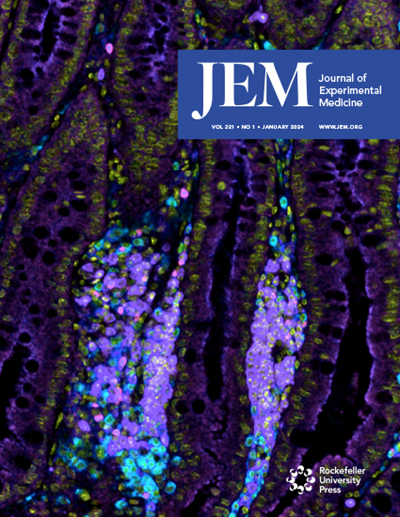FOXP3 可根据上下文情况抢夺转录因子。
IF 12.6
1区 医学
Q1 IMMUNOLOGY
Journal of Experimental Medicine
Pub Date : 2024-09-02
Epub Date: 2024-07-01
DOI:10.1084/jem.20240940
引用次数: 0
摘要
FOXP3劫持DNA结合蛋白以调控基因表达。在本期的《微生物学报》上,He 等人(https://doi.org/10.1084/jem.20232068)提出了一个动态模型,在这个模型中,FOXP3 与 DNA 结合蛋白结合以调节 Treg 细胞的功能,从而对环境线索做出反应。本文章由计算机程序翻译,如有差异,请以英文原文为准。
FOXP3 snatches transcription factors depending on the context.
FOXP3 hijacks DNA-binding proteins to regulate gene expression. In this issue of JEM, He et al. (https://doi.org/10.1084/jem.20232068) propose a dynamic model in which FOXP3 associates with DNA-binding proteins to regulate Treg cell function in response to environmental cues.
求助全文
通过发布文献求助,成功后即可免费获取论文全文。
去求助
来源期刊
CiteScore
26.60
自引率
1.30%
发文量
189
审稿时长
3-8 weeks
期刊介绍:
Since its establishment in 1896, the Journal of Experimental Medicine (JEM) has steadfastly pursued the publication of enduring and exceptional studies in medical biology. In an era where numerous publishing groups are introducing specialized journals, we recognize the importance of offering a distinguished platform for studies that seamlessly integrate various disciplines within the pathogenesis field.
Our unique editorial system, driven by a commitment to exceptional author service, involves two collaborative groups of editors: professional editors with robust scientific backgrounds and full-time practicing scientists. Each paper undergoes evaluation by at least one editor from both groups before external review. Weekly editorial meetings facilitate comprehensive discussions on papers, incorporating external referee comments, and ensure swift decisions without unnecessary demands for extensive revisions.
Encompassing human studies and diverse in vivo experimental models of human disease, our focus within medical biology spans genetics, inflammation, immunity, infectious disease, cancer, vascular biology, metabolic disorders, neuroscience, and stem cell biology. We eagerly welcome reports ranging from atomic-level analyses to clinical interventions that unveil new mechanistic insights.

 求助内容:
求助内容: 应助结果提醒方式:
应助结果提醒方式:


